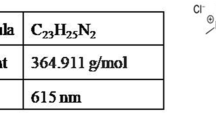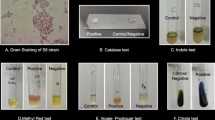Abstract
Pterin is a member of the compounds known as pteridines. They have the same nucleus of 2-amino-4-hydroxypteridine (pterin); however, the side-chain is different at the position 6, and the state of oxidation of the ring may exist in different form viz. tetrahydro, dihydro, or a fully oxidized form. In the present study, the microorganisms able to utilize cyanide, and heavy metals have been tested for the efficient production of pterin compound. The soil samples contaminated with cyanide and heavy metals were collected from Salem steel industries, Tamil Nadu, India. Out of 77 isolated strains, 40 isolates were found to utilize sodium cyanate as nitrogen source at different concentrations. However, only 13 isolates were able to tolerate maximum concentration (60 mM) of sodium cyanate and were screened for pterin production. Among the 13 isolates, only 1 organism showed maximum production of pterin, and the same was identified as Bacillus pumilus SVD06. The compound was extracted and purified by preparative high-performance liquid chromatography and analyzed by UV/visible, FTIR, and fluorescent spectrum. The antioxidant property of the purified pterin compound was determined by cyclic voltammetry. In addition, antimicrobial activity of pterin was also studied which was substantiated by antagonistic activity against Escherichia coli, and Pseudomonas aeruginosa. Besides that the pterin compound was proved to inhibit the formation of biofilm. The extracted pterin compounds could be proposed further not only for antioxidant and antimicrobial but also for its potency to aid as anticancer and psychotic drugs in future.




Similar content being viewed by others
References
Allen KD, Xu H, White RH (2014) Identification of a unique radical S-adenosylmethionine methylase likely involved in methanopterin biosynthesis in Methanocaldococcus jannaschii. J Bacteriol 196:3315–3323. https://doi.org/10.1128/JB.01903-14
Altschul SF, Madden TL, Schäffer AA, Zhang J, Zhang Z, Miller W, Lipman DJ (1997) Gapped BLAST and PSI-BLAST: a new generation of protein database search programs. Nucleic Acids Res 25:3389–3402
Arteaga JF, Ruiz-Montoya M, Palma A, Alonso-Garrido G, Pintado S, Rodríguez-Mellado JM (2012) Comparison of the simple cyclic voltammetry (CV) and DPPH assays for the determination of antioxidant capacity of active principles. Molecules 17:5126–5138. https://doi.org/10.3390/molecules17055126
Benham JL, West R (1980) Oxidation and reduction properties of anthraquinocyclopropanes and anthraquinocyclopropenes. J Am Chem Soc 102:5054–5058. https://doi.org/10.1021/ja00535a038
Bharath G, Madhu R, Chen SM, Veeramani V, Mangalaraj D, Ponpandian N (2015) Solvent-free mechanochemical synthesis of graphene oxide and Fe3O4-reduced graphene oxide nanocomposites for sensitive detection of nitrite. J Mater Chem A 3(30):15529–15539. https://doi.org/10.1039/C5TA03179F
Biondi R, Ambrosio G, De Pascali F, Tritto I, Capodicasa E, Druhan LJ, Hemann C, Zweier JL (2012) HPLC analysis of tetrahydrobiopterin and its pteridine derivatives using sequential electrochemical and fluorimetric detection: application to tetrahydrobiopterin autoxidation and chemical oxidation. Arch Biochem Biophys 520(1):7–16. https://doi.org/10.1016/j.abb.2012.01.010
Cabrerizo FM, Dantola ML, Thomas AH, Lorente C, Brau AM, Oliveros E, Capparelli AL (2004) Photooxidation of pterin in aqueous solutions: biological and biomedical implications. Chem Biodivers 1:1800–1811. https://doi.org/10.1002/cbdv.200490135
Cho SH, Na JU, Youn H, Hwang CS, Lee CH, Kang SO (1998) Tepidopterin, 1-O-(L-threo-biopterin-2′-yl)-β-N-acetylglucosamine from Chlorobiumtepidum. Biochim Biophys Acta 1379:53–60. https://doi.org/10.1016/S0304-4165(97)00081-0
Christensen GD, Simpson WA, Younger JA (1995) Adherence of coagulase negative Staphylococci to plastic tissue cultures: a quantitative model for the adherence of Staphylococci to medical devices. J Clin Microbiol 22:996–1006
Coates J (2000) Interpretation of infrared spectra: a practical approach. In: Meyers RA (ed) Encyclopedia of analytical chemistry. Wiley, Chichester
Daniel A, Kunz l, Runy F (2001) Evidence that bacterial cyanide oxygenase is a pterin-dependent hydroxylase. Biochem Biophys Res Commun 287:514–518. https://doi.org/10.1006/bbrc.2001.5611
Davis MD, Kaufman S, Milstien S (1988) The auto-oxidation of tetrahydrobiopterin. Eur J Biochem 173(2):345–351. https://doi.org/10.1111/j.1432-1033.1988.tb14004.x
Dorr PK, Knowles CJ (1989) Cyanide oxygenase and cyanase activities of Pseudomonas fluorescens NCIMB 11764. FEMS Microbiol Lett 60:3–289. https://doi.org/10.1111/j.1574-6968.1989.tb03488
Fernandez RF, Dolghih E, Kunz DA (2004) Enzymatic assimilation of cyanide via pterin-dependent oxygenolytic cleavage to ammonia and formate in Pseudomonas fluorescens NCIMB 11764. Appl Environ Microbiol 70:121–128. https://doi.org/10.1128/AEM.70.1.121-128.2004
Forrest HS, Van Baalen C, Myers J (1957) Occurrence of Pteridines in a blue-green alga. Science 125:699–700. https://doi.org/10.1126/science.125.3250.699
Fukushima T, Nixon JC (1980) Analysis of reduced forms of biopterin in biological tissues and fluids. Anal Biochem 102(1):176–188. https://doi.org/10.1016/0003-2697(80)90336-X
Gupta N, Balomajumder C, Agarwal VK (2010) Enzymatic mechanism and biochemistry for cyanide degradation: a review. J Hazard Mater 176:1–3. https://doi.org/10.1016/j.jhazmat.2009.11.038
Hatfield DL, Van Baalen C, Forrest HS (1961) Pteridines in blue green algae. J Physiol 36:240. https://doi.org/10.1104/pp.36.2.240
Hwang YK, Kang JY, Woo HJ, Choi YK, Park YS (2002) Functional investigation of a gene encoding pteridine glycosyltransferase for cyanopterin synthesis in Synechocystis sp. PCC 6803. Biochim Biophys Acta 1570:141–144. https://doi.org/10.1016/S0304-4165(02)00156-
Kaim W (1987) Heterocycles with 7 and 8π electrons. Models for flavin and pteridine intermediates and candidates for novel inorganic rings. Rev Chem Intermed 8:247–248. https://doi.org/10.1002/chin.201126118
Kampis IM, Islam K, Then RL (2005) DNA and RNA synthesis: antifolates. Chem Rev 105:593. https://doi.org/10.1021/cr0301144
Kaneko YS, Mori K, Nakashima A, Nagatsu I, Nagatsu T, Ota (2001) A determination of tetrahydrobiopterin in murine locus coeruleus by HPLC with fluorescence detection. Brain Res Brain Protoc 8:25–31. https://doi.org/10.1016/S1385-299X(01)00081-2
Kanmani P, Lim TS (2013) Synthesis and structural characterization of silver nanoparticles using bacterial exopolysaccharide and its antimicrobial activity against food and multidrug resistant pathogens. Process Biochem 48:1099–1106. https://doi.org/10.1016/j.procbio.2013.05.011
Kunz DA, Fernandez RF, Parab P (2001) Evidence that bacterial cyanide oxygenase is a pterin-dependent hydroxylase. Biochem Biophys Res Commun 287:514. https://doi.org/10.1099/mic.0.045286-0
Kunz DA, Nagappan O, Silva-Avalos J, Delong GT (1992) Utilization of cyanide as a nitrogenous substrate by Pseudomonas fluorescens NCIMB 11764: evidence for multiple pathways of metabolic conversion. Appl Environ Microbiol 58:2022–2029. https://doi.org/10.1111/j.1574-6968.1997
Lee HW, Oh CH, Geyer A, Pfleiderer W, Park YS (1999) Characterization of a novel unconjugated pteridine glycoside, cyanopterin, in Synechocystis sp. PCC 6803. Biochim Biophys Acta 14(10):1–61. https://doi.org/10.1016/S0005-2728(98)00175-3
Maniatis TT (1982) Molecular cloning: a laboratory manual. (No. 04; QH442. 2, M3.)
Melber C, Schmidt GH (1992) Quantitative variations in the pteridines during the post-embryonic development of Dysdercus species (Heteroptera: Pyrrhocoridae). Comp Biochem Physiol B Biochem Mol Biol 108:79–94. https://doi.org/10.1016/0305-0491(94)90168-6
Meyers PR, Gokooln P, Rawlings DE, Woods DR (1991) An efficient cyanide-degrading Bacillus pumilus strain. Microbiology 137:1397–4000. https://doi.org/10.1099/00221287-137-6-1397
Moheno PBB (2017) A review of the development of calcium pterins and calcium folate for the immunotherapy of certain diseases. Drug Design 6:140. https://doi.org/10.4172/2169-0138.1000140
Feirer N, Xun J, Allen KD, Koestler BJ, Bruger EL, Waters CM, White RH, Fuqua C (2015) A pterin-dependent signaling pathway regulates a dual-function diguanylate cyclase-phosphodiesterase controlling surface attachment in Agrobacterium tumefaciens. MBio 30:e00156. https://doi.org/10.1128/mBio.00156-15
Nisshanthini SD, Raja DS, Natarajan K, Palaniswamy M, Angayarkanni J (2015) Spectral characterization of a pteridine derivative from cyanide-utilizing bacterium Bacillus subtilis-JN989651. J Microbiol 53:262–71. https://doi.org/10.1007/s12275-015-4138-0
Noguchi Y, Ishii A, Matsushima A, Haishi D, Yasumuro K, Moriguchi T, Wada T, Kodera Y, Hiroto M, Nishimura H, Sekine M, Inada Y (1999) Isolation of biopterin-a-glucoside from Spirulina (Arthrospira) platensis and its physiologic function. Mar Biotechnol 1(2):207–210. https://doi.org/10.1007/PL00011769
Pfleiderer W (1992) Pteridines properties reactivities and biological significance. J Heterocycl Chem 29:583–605. https://doi.org/10.1002/jhet.5570290301
Pribat A, Blaby IK, Lara-Nunez A, Jesse F, Gregory, de Crecy-Lagard V, Hanson AD (2010) FolX and FolM are essential for tetrahydromonapterin synthesis in Escherichia coli and Pseudomonas aeruginosa. J Bacteriol 192:475–482. https://doi.org/10.1128/JB.01198-09
Rembold (1975) Reduced pteridines as possible mediators in cellular electron transfer. In: Chemistry and biology of pteridines. Walter de GruyterVerlag, Berlin
Stepanovic S, Vukovi D, Hola V (2007) Quantification of biofilm in microtiter plates: overview of testing conditions and practical recommendations for assessment of biofilm production by Staphylococci. APMIS 115:891–899
Weisberg WG, Barns SM, Pelletier DA, Lane DJ (1991) 16S ribosomal DNA for phylogenetic study. J Bacteriol 173:697–703. https://doi.org/10.1128/jb.173.2.697-703.1991
Wijnen B, Leertouwer HL, Stavenga DG (2007) Colors and pterin pigmentation of pierid butterfly wings. J Insect Physiol 53:1206–1217. https://doi.org/10.1016/j.jinsphys.2007.06.016
Acknowledgements
The authors are indebted to Dr Jayanthi R. (Principal Scientist and Head) and Dr Salin K.P. (Principal Scientist), Department of Entomology, Sugarcane Breeding Institute, Coimbatore 641 007 for their kind assistance with analytical and preparative HPLC analysis.
Author information
Authors and Affiliations
Corresponding author
Electronic supplementary material
Below is the link to the electronic supplementary material.
Rights and permissions
About this article
Cite this article
Mahendran, R., Thandeeswaran, M., Kiran, G. et al. Evaluation of Pterin, a Promising Drug Candidate from Cyanide Degrading Bacteria. Curr Microbiol 75, 684–693 (2018). https://doi.org/10.1007/s00284-018-1433-0
Received:
Accepted:
Published:
Issue Date:
DOI: https://doi.org/10.1007/s00284-018-1433-0




